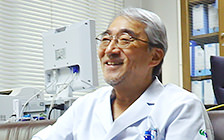
Anal fistula cannot be completely cured by conservative therapy, and therefore surgery is required for a complete cure of this condition. Surgical procedures vary widely depending on the types of anal fistula. In many cases, they cannot be cured by outpatient surgery. Anesthesia is also one of the burdens on patients in the treatment of anal fistula. For patients with an abscess, a local anesthetic is commonly injected into the affected area before incision, and this anesthesia injection itself is very painful. However, I think that the burden on patients is reduced considerably because there is no pain associated with "sacral epidural anesthesia" which is in use at our hospital. Since "sacral epidural anesthesia" is applied only to the perianal area and will wear off in about 2 hours, this anesthesia is being used for various types of surgeries including outpatient surgery.

Anal fistula is caused by "anal abscess" in which pus accumulates in the perianal region and which is caused by bacteria entering a small hole between the anus and rectum and causing inflammation. In some cases, anal fissure becomes severe, resulting in ulceration, and bacteria enters from its deep wound, thereby causing abscess. As anal abscess progresses, a tunnel will develop to drain pus to the anal and perianal skin, which is anal fistula. When anal fistula worsens, pus continues to drain from the hole formed on the skin. In such a state, the patient’s underwear gets soiled but pus does not accumulate and there is no pain. However, leaving anal fistula untreated may pose risks. There have been cases in which anal fistula left untreated for more than 10 years developed into cancer. There are some patients who left anal fistula untreated for years because they were planning to receive treatment after retirement but in whom anal fistula had already become cancerous. Therefore, patients with anal fistula must not delay visiting a hospital for treatment.

Anal fistula is not usually purulent but often becomes purulent when patients with anal fistula have diarrhea or such. Anal fistula requires surgery. Anal fistula is a condition in which a core-like tube called a "fistula" to drain pus to the perianal skin is formed, so anal fistula surgery is performed to remove a fistula. It was said previously that anal fistula occurs in 100% of patients with "anal abscess," which might be the cause of anal fistula. However, recently, it has been said that, in about 20% to 30% of patients, anal abscess is resolved without causing anal fistula. At our hospital, early treatment with surgery is recommended for anal fistula that is detected as a well-defined mass. For most patients presenting with anal fistula, surgery is recommend at the first visit to our hospital. Even if surgery is not scheduled at the first visit, patients must undergo surgery when they revisit our hospital for recurrence of anal fistula. The reason is that anal fistula may repeatedly recur, during which time pus may drain from a different site, resulting in the formation of complicated fistulae. Excision of extensive areas is required for complicated fistulae.

For anal fistula, surgery may be the sole effective treatment. The most common conventional procedure for anal fistula involves the formation of a fistula tract for pus drainage from the anal canal to the perianal skin and looping a rubber band through the tract and gradually tightening the band to slowly incise the fistula. With this method, such incisions heal gradually during the duration of 4 to 5 months. Meanwhile, "sphincter preservation" which does not involve incision of muscles has been employed in recent years at specialized hospitals. At our hospital, "ligation of intersphincteric fistula tract (LIFT) surgery" is performed, which involves ligation of the intersphincteric tract (for pus drainage) close to the internal opening and removal of the intersphincteric tract, scraping out the remainder of the fistulous tract not related to the external sphincter muscle. Bacteria cannot enter the external fistulous tract, and this portion withers and disappears.
